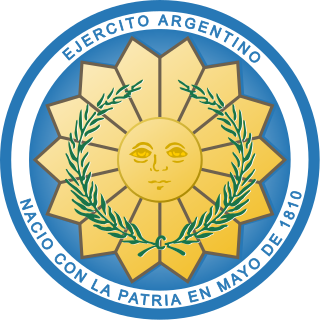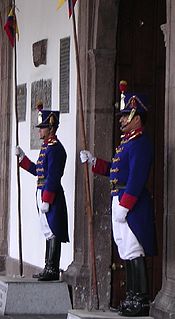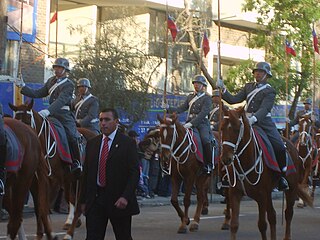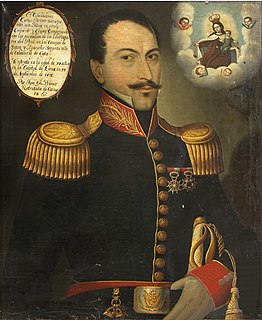
Dragoons were originally a class of mounted infantry, who used horses for mobility, but dismounted to fight on foot. From the early 17th century onward, dragoons were increasingly also employed as conventional cavalry and trained for combat with swords and firearms from horseback. While their use goes back to the late 16th century, dragoon regiments were established in most European armies during the 17th and early 18th centuries; they provided greater mobility than regular infantry but were far less expensive than cavalry.

A hussar was a member of a class of light cavalry, originating in Central Europe during the 15th and 16th centuries. The title and distinctive dress of these horsemen were subsequently widely adopted by light cavalry regiments in European armies in the late 17th and early 18th centuries.

The Government Palace, also known as the House of Pizarro, is the seat of the executive branch of the Peruvian Government, and the official residence of the President of Peru. The palace is a stately government building, occupying the northern side of the Plaza Mayor in Peru's capital city, Lima. Set on the Rímac River, the palace occupies the site of a very large huaca that incorporated a shrine to Taulichusco, the last kuraka of Lima.

The Battle of Ayacucho was a decisive military encounter during the Peruvian War of Independence. This battle secured the independence of Peru and ensured independence for the rest of South America. In Peru it is considered the end of the Spanish American wars of independence, although the campaign of victor Antonio José de Sucre continued through 1825 in Upper Peru and the siege of the fortresses Chiloé and Callao eventually ended in 1826.

The Structure of the Argentine Army follows below. As of 2020 the active force of the Argentine Army includes a total of eleven brigades:

Domingo Nieto was a Peruvian Grand Marshal, forefather of the nation, and politician who served as the 19th President of Peru between 1843 and 1844, officially as the President of the Government Junta and Grand Marshal of Peru.

The Peruvian Army is the branch of the Peruvian Armed Forces tasked with safeguarding the independence, sovereignty and integrity of national territory on land through military force. Additional missions include assistance in safeguarding internal security, conducting disaster relief operations and participating in international peacekeeping operations. It celebrates the anniversary of the Battle of Ayacucho (1824) on December 9.

The Peruvian National Police is the national police force of Peru. Its jurisdiction covers the nation's land, sea, and air territories. Formed from the merge of the Investigative Police, the Civil Guard, and the Republican Guard in 1988, it is one of the largest police forces in Latin America. Its mission is to preserve domestic order, public order and national security, in order to enforce the law and protect the people of Peru. The PNP is controlled by the Ministry of the Interior (Peru). The PNP has a number of divisions, tasked with enforcing specific aspects of the law; among the more well known are DIROES, DIRANDRO, DIRINCRI, and DIRCOTE (Anti-Terrorism).

The 1st Infantry Regiment "Los Patricios" is the oldest and one of the most prestigious regiments of the Argentine Army. The title is often shortened to the Patricians' Regiment. Since the 1990s the regiment has been designated as air assault infantry. It is also the custodian of the Buenos Aires Cabildo, the welcoming party for visiting foreign dignitaries to Argentina and the escort, and honor guard battalion for the City Government of Buenos Aires. Since 22 September 2010, the Regiment's headquarters building has been a National Historical Monument following a declaration by the Argentine government on the occasion of the country's bicentennial year.
The Battle at Tacna was an engagement during the War of the Pacific (1879–1883) between Chile and the Allied Forces of Peru and Bolivia. It was fought on May 20, 1880, with the forces aligned as follows:

The Battle of Tarqui, also known as the Battle of Portete de Tarqui, took place on 27 February 1829 at Portete de Tarqui, near Cuenca, Ecuador. It was fought between troops from Gran Colombia, commanded by Antonio José de Sucre, and Peruvian troops under José de La Mar.
This is an order of battle of the Chilean Army.

The 1st Regiment of Foot Infantry "Bolivian Colorados" National Presidential Escort Regiment of the Bolivian Army, formerly the 39th Line Infantry Battalion "Colorados" is one of the Army's oldest and most prestigious infantry regiments. It is headquartered in La Paz's Miraflores District, and is under the direct supervision of Bolivian Army headquarters.

On July 29 every year, the Great Military Parade of Peru celebrating the anniversary of Peru's declaration of independence from Spain in 1821 is held in Lima, the national capital, by members of the Peruvian Armed Forces and the National Police of Peru and is presided over by the President of Peru and his First Family, members of the Council of Ministers of Peru and the Congress of the Republic of Peru, other civil officials, ecclesiastical leaders, the Diplomatic Corps of Peru, and other invited guests, among them commanders and other officers and personnel of the Armed Forces and the National Police.

The British cavalry were the first British Army units to see action during the First World War. Captain Hornby of the 4th Dragoon Guards is reputed to have been the first British soldier to kill a German soldier, using his sword, and Drummer Edward Thomas of the same regiment is reputed to have fired the first British shot shortly after 06:30 on 22 August 1914, near the Belgian village of Casteau. The following Battle of Mons was the first engagement fought by British soldiers in Western Europe since the Battle of Waterloo, ninety-nine years earlier. In the first year of the war in France nine cavalry brigades were formed for three British cavalry divisions. Other regiments served in six brigades of the two British Indian Army cavalry divisions that were formed for service on the Western Front. Three regiments also fought in the campaign in Mesopotamia, the only other theatre of the First World War where British cavalry served.

A mounted band is a military or civilian musical ensemble composed of musician playing their instruments while being mounted on an animal. The instrumentation of these bands are limited, with the musician having to play his/her instrument, as well as steer the animal to the designated location. Most mounted bands, therefore, use instruments that can easily be held, such as bugles, horns, and Fanfare trumpets. Timpani and glockenspiels are also a common feature, usually located at the head of a band. Although a band that is mounted on any member of the families Equidae and Camelidae are considered to be a mounted band, horses are most commonly used, mostly being employed in military bands in Europe, North and South America, and some parts of Asia.

The Presidential Escort Group "Granaderos de Tarqui is the President of Ecuador's honour guard service regiment, which protects the Carondelet Palace in Quito. Granaderos de Tarqui, means Tarqui Grenadiers in Spanish.

The 1st Cavalry Regiment "Grenadiers" is the senior cavalry regiment of the Chilean Army, which serves as the Horse Guards unit providing the ceremonial escort in parades and ceremonies to the President of Chile, the Supreme Commander of the Chilean Armed Forces. It provides the guard during flag raising ceremonies monthly in Santiago, the national capital. Together with the 3rd Cavalry Regiment "Hussars" it forms the remaining mounted components of the army in active service.

Cosme Pacheco, was a Peruvian lieutenant-colonel during the Peruvian War of Independence and revolutionary wars in Perú. He was assigned to the cavalry of the Army of Peru in the Regiments of Hussars of Junín Province and the Lancers of Cusco. He participated in the military campaigns for the independence of Peru from 1821 to 1825. He was awarded the medals of the Battle of Junin and the Battle of Ayacucho. Later, he fought in military campaigns of the south of Peru and the Upper Peru, as well as in the Peruvian-Bolivian conflict, between 1825 and 1828. Retired from active military service, he was recalled to service in 1835 by the request of the Supreme Provisory Board of Government of the Republic of Peru. He actively participated in revolutions and civil wars in his country, collaborating with the highest authorities as emissary and peacemaker in the central highlands of Peru. He died in the region of his birth, Department of Cusco, of unknown causes, presumably around 1851.




















